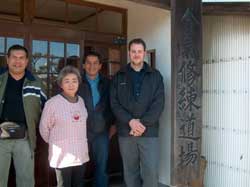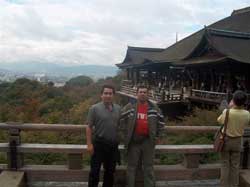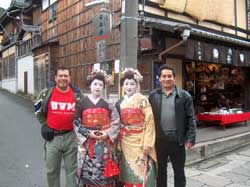Oct 2004
Organized and Sponsored by AHAN.
AHAN headquarters in Denver, Colorado sponsored the official IISA tour to Japan this past Oct/Nov 2004. The purpose of the trip was to truly experience Japan. It was my belief that this new understanding would make me a wiser instructor with a wider point of view.
I am Fernando Roman, chief instructor of Mexico Aikido Takemusu Aiki in Mexico City and also the official representative for AHAN Mexico. I went on this trip with Mexico Aikido Instructor Jose Alvarez, and with Homma Kancho of Nippon Kan as a guide, we saw more of Japan than I ever imagined. As a serious Aikido Instructor it has always been my dream to visit Japan, and with this trip my dream came true. This trip was made possible through the support of AHAN Headquarters in Denver, Colorado, and Homma Kancho. The following is a report on the incredible adventure we had.
Homma Kancho had returned from Brazil just three days before we left for Japan. We met him, and Edward Deiro from Milwaukee at the Houston airport. After twelve hours in flight we arrived in Tokyo, where we spent our first night in Ueno. Homma Kancho chose Ueno because of its convenience as a departure point to places outside of Tokyo. We woke at dawn the next morning to attend morning practice at Aikikai Hombu in Tokyo. Asa geiko (morning practice) began at 6:30 under Doshu Moriteru Ueshiba’s instruction. I was so excited to be at practice at Hombu dojo and was very proud that Doshu was friendly and hospitable to us. Any time that a foreigner to Japan like myself has a chance to see Doshu, it usually is at a seminar with hundreds of people. To be able to say hello to Doshu in person was a very valuable experience for me. After practice we had a chance to see the dojo before changing.
After we changed, we walked back through the dojo and I was surprised to see that many students, foreigners and Japanese students were practicing what looked like Iado with
swords and bokken. This was a surprise to me. My understanding had been that the official position of Aikikai was that there was no relation between swords and open hand Aikido movement. In books and videos I have seen of Doshu there are no techniques performed with a ken or a jo. Bukiwaza like tachidori or tantodori was included, but no movement with a bokken or jo. I concluded that since this after class practice was being held that it was acceptable to the Hombu staff. If the students were practicing Karate after class for example I would assume that they would be asked to stop.
As I left Hombu dojo I felt happy and honored that I had finally had this opportunity. As we headed back to the hotel, I still felt a little puzzled by the after class practice being held. As a visitor, far from home, I reflected, discrepancy in policy at the source reverberates even more as they reach those on the outskirts of this Aikido world.
That afternoon we headed east from Tokyo to Iwama, home of the Aiki Jinja which to me was a great monument to the practice of the Founder Ueshiba. After arriving, we paid our respects at the Aiki shrine and went to visit Iwama Shin shin Aiki Shuren Jukucho Hitohiro Saito Sensei. It was at his dojo that we were to stay. For the second time that day we prepared for practice there. Saito Sensei taught very important basics patiently and precisely, and led a wonderful practice. We were welcomed with the utmost in hospitality and were treated to a dinner that we shared with Saito Sensei. We stayed with the uchideshi at the dojo who took great care to make sure we were comfortable. After a well earned sleep, we got up early to visit the Aiki Jinja and the dojo where the Founder lived one last time. It was such a monument for not only me I think, but for Aikidoka all over the world.
A few minutes later, in the chill of the morning, Saito Sensei led a morning meditation (tanren juku) for all of the uchideshi which included many foreigners besides us. After this meditation we all went for a light jog in the woods followed by outside bokken practice led by Saito Sensei. You could see your breath when we started, but by the time we had finished we had worked up a sweat. After breakfast at the dojo we prepared to leave. Saito Sensei gave us steamed potatoes and bananas for our journey ahead and even accompanied us to the train station. As our train approached we turned to board when we heard a big voice from the gate. He yelled for us to stop as he ran toward us with a bag of drinks he had bought inside the station. “You need something to drink too…” he said with a smile.
- Hitohiro Jukucho teaching me basic points.
- Morning practice in the forest.
- With Hitohiro Saito Jukucho.
- In Front of the Aiki Jinja.
We continued on our journey traveling northwest to Akita in Northern Honshu. These days the bullet train can make it from Tokyo to Akita in three and a half hours. Homma Kancho told us that when he was young, the trip from Akita took over ten hours by train. Akita is Homma Kancho’s hometown, and also the home of former Aikikai Akita Branch director, the late Shigeru Kawabe Shihan. His dojo is still there however, Kawabe Shihan’s son Ryusaku Kawabe having taken over his father’s duties as dojo cho, assisted by Hitoshi Iizuka. We went to visit Kawabe Sensei’s dojo and had a good practice with students there. After practice, all of the students joined in for a welcome party at the dojo. We got to sample many local delicious foods prepared with care by Mrs. Kawabe, the late Kawabe Shihan’s widow. She was a wonderful woman who took care of us like a “mom”. During our overnight stay at the dojo, Mrs. Kawabe prepared all of our meals. My sincerest thanks to Mrs. Kawabe for her generosity and kindness; all of us had a wonderful time.
- Ryusaku Kawabe Kancho and dojo members.
- With Mrs Kawabe, widow of Shigeru Kawabe Shihan.
We were very excited to learn that Aikikai Hombu Shihan Masatake Fujita Shihan and his wife would be joining Homma Kancho and us in Higashi Naruse at the Kurikoma Hot Springs Resort. Mrs. Fujita we learned, was from Akita, and they had been in Akita visiting family and to see the changing of the fall leaves. Fujita Shihan is a very busy Aikikai instructor, traveling and teaching Aikido in many countries outside of Japan much of the year. Fujita Shihan often comes to Mexico, and it was a stroke of great luck that we had this chance to meet with him and enjoy the springs and a wonderful meal together here deep in the mountains of Northern Japan. We very much appreciate the time that he spent with us.The next morning we left Akita, traveling first by train and then east about two hours by car up into the mountains to the village of Higashi Naruse. Higashi Naruse village, nestled deep in the mountains of Northern Honshu, has had a cross-cultural exchange relationship with Nippon Kan for over 14 years. Current Nippon Kan Instructors Jeremy and Tracy Olive, Nippon Kan senior student Dr. Marc Voelkel are among the dozen or so students from Nippon Kan who have lived in the village for three to six month terms. In all, over 300 people from Denver and Higashi Naruse Village have participated in cross-cultural exchange visits. This fall, Nippon Kan graduateuchideshi Scott Roney arrived in Higashi Naruse where he is working in the village government educational department.
The second half of our travels through Japan began in Western Honshu where Homma Kancho took us to visit Sanjusan Gendo temple, the place where Musashi Miyamoto the infamous Japanese swordsman fought a battle. It was from this place that we began our tour of famous temples in Kyoto, temples I had only in the movies or in photos. They were unbelievable to see in person, and I was so impressed to see how well preserved and taken care of each temple was. You could see these temples today in much the same condition that they were hundreds of years ago. I felt like I was experiencing a real part of Japanese heart and beauty as well as history in this magical place.
- Kyoto’s Sanjusan Gendo temple.
- Kyoto Kiyomizu temple.
Since we had made it all the way to Kyoto, Homma Kancho suggested that we visit Tanabe, the birthplace of the Founder Morihei Ueshiba. We got back on the train and headed
south. The train ride was a beautiful one, with the ocean to one side and the hills on the other, dotted with hundreds of mikan (Japanese tangerines) farms. The mikan trees we passed were all turning brilliant fall colors, which made the ride all the more beautiful. The first thing we saw as we left the Kii Tanabe train station was a large landmark carving dedicated to Aikido. From the station we took a taxi to the Kozanji temple which is the final resting place of the Founder. We paid our respects at the Founder’s grave and then set out to find landmarks of his early life in Tanabe. We visited a bronze statue of the Founder at Tanabe Ohama. At the Motomachi Mera sports center there was a carved stone monument to the Founder’s life. We found the place in Motomachi where the house the Founder had been born in had stood; there is still a plaque that marks the spot. All of this we did under the guidance of Homma Kancho in less than three hours. Without Homma Kancho as a guide, we never would have been able to negotiate this town of 70,000 by ourselves.
- The Founder Ueshiba’s grave.
- Kozangi temple.
From Tanabe we headed by train to Tokyo. In Tokyo we visited the Emperor’s Palace, climbed the Tokyo tower, went to the Ginza, Shinjuku, Akihabara, Asakusa and many
other parts of Tokyo. One highlight was to visit Ueno Eishoji temple the location where Jigoro Kano’s first Judo practice was held. From there we visited the current Kodokan Judo Headquarters. A very formal and kindly elderly woman showed us around the facility and gift shop, staying with us to answer questions. The Judo museum is open to the public so we stopped there and also had a chance to see the dojo on the eighth floor. It was a comfortable visit, and everyone was very gracious and welcoming. Judo students and staff members that we passed were courteous and well mannered. I was impressed with the presentation that the Kodokan gives to visitors and made a mental note of that.
- In front of the Eishoji temple.
- Jigoro Kano’s bronze statue in front of the Kodokan.
Returning to Tokyo for our last day in Japan, Homma Kancho asked us if we wanted to practice one more time at Aikikai Hombu. Jose and I looked at each other and I answered quietly “No thank you”. Before we had come to Japan with Homma Kancho, Hombu dojo to me symbolized all of Japan and Aikido. On this trip we had been exposed to so many experiences of Japan, met so many people and been treated to so much hospitality, my head was still spinning with it all. We had seen the high-tech, cutting edge sides of Tokyo and the century’s old grace and wisdom of Kyoto and Nikko. We had had a chance to practice Aikido in Iwama, and Akita, and were able to spend time with Fujita Shihan in Higashi Naruse Village. With all of these new experiences, I was glad and honored that I had been able to visit Aikikai Hombu for it is a part of our Aikido history, but with all of these new experiences I felt like I had gained a new perspective on its place in the world.Our trip was not yet finished though, and Homma Kancho had one more place he wanted us to see. Back on the train again we headed for Nikko to see the famous burial grounds and temple complexes of the Tokugawa Shogunate. The place was awe inspiring and the changing color of the leaves made this a magnificent place in deed.
Right now, I am Dojo Cho of Mexico Aikido Take Musu Aiki. I am also the official representative of AHAN Mexico, and am working to teach and lead others in AHAN activities and philosophies. I have learned many, many things on this trip, and I am sure I will continue to learn from this trip as my memory of all the events catches up. In the thirteen days that we were here in Japan under Homma Kancho’s guidance we were able to see and do more than most visitors to this country are able to do in thirteen weeks! Sometimes I felt like a pin ball we moved around so much.
Homma Kancho has amazing physical energy and stamina. We had trouble keeping up with his pace sometimes; the days started very early each morning and ended very late in the evenings. In Kyoto and Nikko the temples had many steps and stairs that Homma Kancho navigated with ease. His strength is pretty amazing too!
Homma Kancho told us that he had taken over 600 people to Japan. For all of these people and for us too, his purpose was to show the “real” Japan; to show us the places that visitors from other countries never usually get to see.
We thank Homma Kancho for an incredible experience that we will never forget; it was an adventure of a lifetime. We also thank all of the people that we met in Japan who took care of us with such graciousness and warmth.
Domo Arigato, Muchos Gracias.
Fernando Roman
Mexico Aikido, Take Musu Aiki
AHAN Mexico Nippon Kan


















